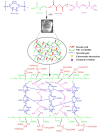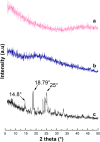Optimization, in vitro release and toxicity evaluation of novel pH sensitive itaconic acid-g-poly(acrylamide)/sterculia gum semi-interpenetrating networks
- PMID: 33899162
- PMCID: PMC8149496
- DOI: 10.1007/s40199-021-00395-8
Optimization, in vitro release and toxicity evaluation of novel pH sensitive itaconic acid-g-poly(acrylamide)/sterculia gum semi-interpenetrating networks
Abstract
Background: In recent era, pH sensitive polymeric carriers that combines the materials engineering and medicine is gaining researcher's attention as they maximizes drug concentration at site of absorption and reduces side effects for e.g. orally administered cetirizine HCl (CTZ HCl) upsets the stomach and furthermore shows high intestinal absorption. Thus, development of pH sensitive hydrogels with sufficient mechanical strength will be good candidate to address this issue.
Methods: Here, we developed pH sensitive itaconic acid-g-poly(acrylamide)/sterculia gum (IA-g-poly(AM)/sterculia gum) semi-interpenetrating network (semi-IPN) by free radical polymerization technique for intestinal delivery of CTZ HCL.
Results: Optimized formulation (I5) with 6% w/w IA showed negligible swelling at pH 1.2, and maximum swelling at pH 7.4. Solid state characterization of optimized formulation showed successful development of semi-IPN structure and incorporation of drug without any noticeable drug-carrier interaction. In vitro release study showed biphasic pH dependent release of CTZ HCl, where initial burst release was observed at acidic pH followed by sustained release at basic pH. Acute oral toxicity and histopathological studies confirmed the non-toxic nature of IA-g-poly(AM)/sterculia gum.
Conclusion: Conclusively, developed biocompatible semi-IPN hydrogels with sufficient pH sensitivity and mechanical strength could serve as a potential carrier for intestinal delivery of CTZ HCL to maximize its absorption and reduce side effects.
Keywords: Acrylamide; Itaconic acid; Semi-IPN hydrogels; Sterculia gum; pH sensitive.
Conflict of interest statement
The authors declare no conflict of interest.
Figures










Similar articles
-
Development and evaluation of pH sensitive semi-interpenetrating networks: assessing the impact of itaconic acid and aloe vera on network swelling and cetirizine release.Front Bioeng Biotechnol. 2023 May 9;11:1173883. doi: 10.3389/fbioe.2023.1173883. eCollection 2023. Front Bioeng Biotechnol. 2023. PMID: 37229490 Free PMC article.
-
Influence of graphene-oxide nanosheets impregnation on properties of sterculia gum-polyacrylamide hydrogel formed by radiation induced polymerization.Int J Biol Macromol. 2017 Jun;99:699-712. doi: 10.1016/j.ijbiomac.2017.03.037. Epub 2017 Mar 8. Int J Biol Macromol. 2017. PMID: 28284934
-
Synthesis and characterization of thermo- and pH-sensitive poly(vinyl alcohol)/poly(N, N-diethylacrylamide-co-itaconic acid) semi-IPN hydrogels.Biomed Mater. 2012 Jun;7(3):035014. doi: 10.1088/1748-6041/7/3/035014. Epub 2012 Apr 11. Biomed Mater. 2012. PMID: 22493167
-
Recent advances of Sterculia gums uses in drug delivery systems.Int J Biol Macromol. 2021 Dec 15;193(Pt A):481-490. doi: 10.1016/j.ijbiomac.2021.10.145. Epub 2021 Oct 25. Int J Biol Macromol. 2021. PMID: 34710475 Review.
-
Karaya and Kondagogu tree gum carbohydrate polymers: A sustainable source for biobased products.Carbohydr Polym. 2025 Jul 15;360:123609. doi: 10.1016/j.carbpol.2025.123609. Epub 2025 Apr 14. Carbohydr Polym. 2025. PMID: 40399018 Review.
Cited by
-
Development and evaluation of pH sensitive semi-interpenetrating networks: assessing the impact of itaconic acid and aloe vera on network swelling and cetirizine release.Front Bioeng Biotechnol. 2023 May 9;11:1173883. doi: 10.3389/fbioe.2023.1173883. eCollection 2023. Front Bioeng Biotechnol. 2023. PMID: 37229490 Free PMC article.
-
Hydrogels in cancer treatment: mapping the future of precision drug delivery.Front Immunol. 2025 Jul 8;16:1607240. doi: 10.3389/fimmu.2025.1607240. eCollection 2025. Front Immunol. 2025. PMID: 40698090 Free PMC article.
References
-
- Zamani F, Jahanmard F, Ghasemkhah F, Amjad-Iranagh S, Bagherzadeh R, Amani-Tehran M, et al. Nanofibrous and nanoparticle materials as drug-delivery systems. Nanostructures for Drug Delivery. Elsevier. 2017:239–70.
-
- Singh B, Vashishtha M. Development of novel hydrogels by modification of sterculia gum through radiation cross-linking polymerization for use in drug delivery. Nucl Instrum Methods Phys Res, Sect B. 2008;266(9):2009–2020.
-
- Yar M, Shahzad S, Siddiqi SA, Mahmood N, Rauf A, Anwar MS et al. Triethyl orthoformate mediated a novel crosslinking method for the preparation of hydrogels for tissue engineering applications: characterization and in vitro cytocompatibility analysis. Materials Science and Engineering: C. 2015;C 56:154–64. doi:10.1016/j.msec.2015.06.021. - PubMed
-
- Kulkarni RV, Sa B. Novel pH-sensitive interpenetrating network hydrogel beads of carboxymethylcellulose-(polyacrylamide-grafted-alginate) for controlled release of ketoprofen: preparation and characterization. Current Drug Delivery. 2008;5(4):256–264. - PubMed
MeSH terms
Substances
LinkOut - more resources
Full Text Sources
Other Literature Sources

